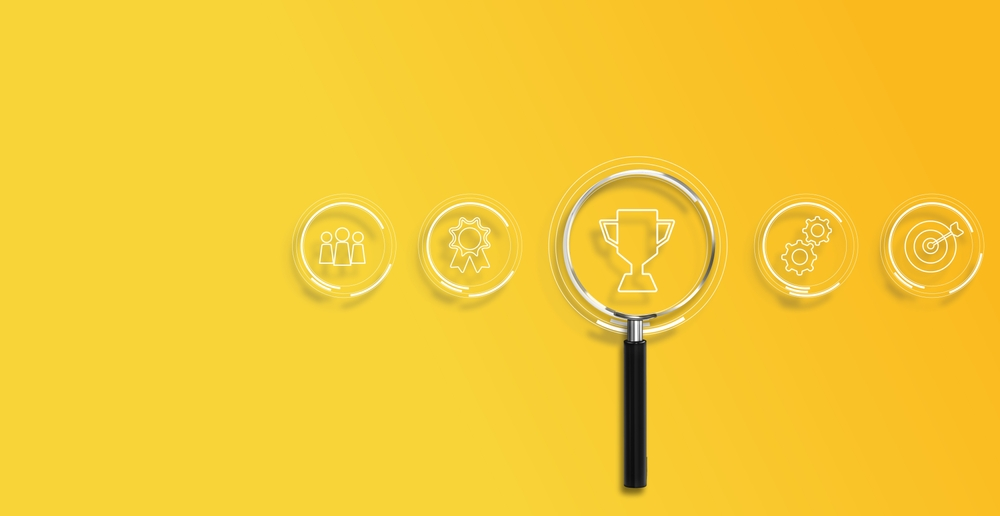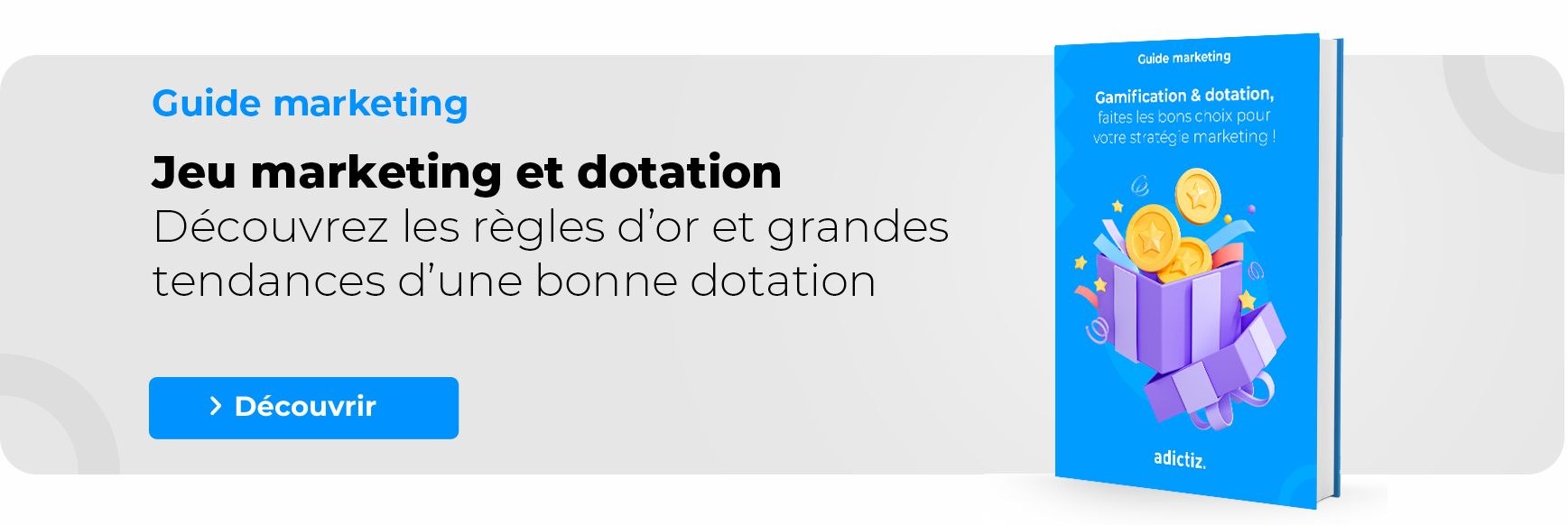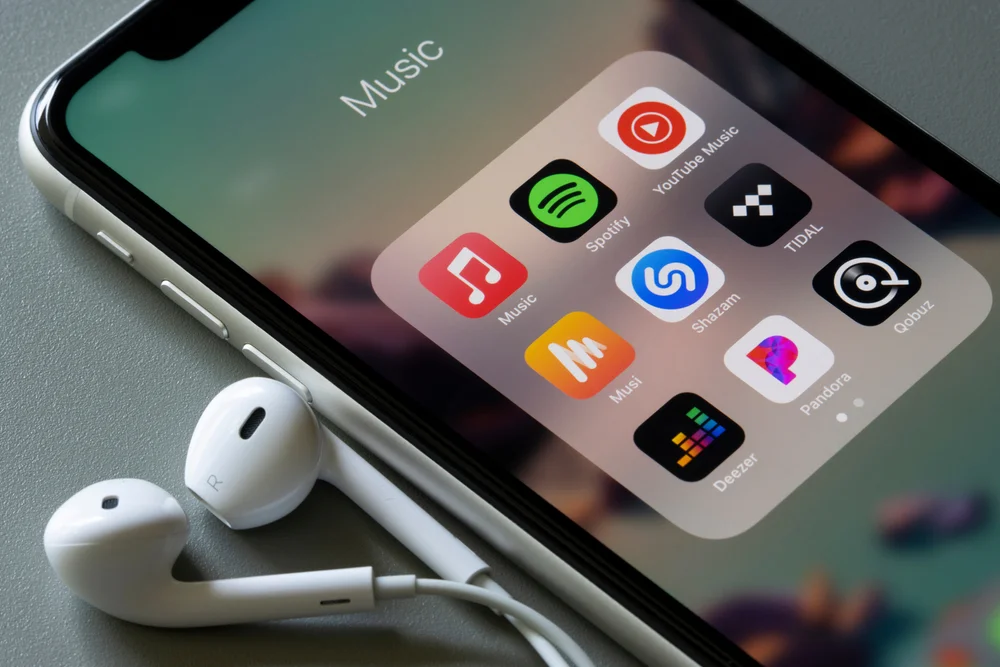It has never been so difficult to capture the attention of your audience.
Today, we receive over 5,000 messages a day. Whether in real life or online, users are increasingly subject to advertising fatigue. In the digital space alone, more than 18,000 advertisers are vying for consumers’ attention. And one French person in 3 uses Adblock precisely to avoid promotional messages.
The challenges of reaching and engaging your target audience are therefore numerous. Brands need to come up with new ways of connecting with their audience and maintaining that connection in order to generate sales and build a community of loyal customers.
One of the tools that can help you stand out from the crowd is gamification marketing, also known as Playable Marketing. This strategy makes it possible to introduce game-like elements into interactions with the audience.
In this guide, we look back at the origins of the concept and its various current applications. We share with you concrete tools to make it a cornerstone of your marketing strategy and an effective lever for achieving all your strategic objectives.
What is gamification?
Gamification refers to the use of mechanisms traditionally found in the world of games. It can involve introducing rewards into the user experience, challenging the audience or even providing levels and rankings to be reached in the customer journey.
The aim of gamification is to stimulate the participation, commitment and motivation of target audiences. By making it more fun and interactive, the proposed experience becomes not only more positive, but also more impactful.
It also enables an exchange to take place between the advertiser and its target audience, enabling various objectives to be pursued (getting to know the target audience better, rewarding them, getting them to take an action such as creating an account, for example).
A brief history of the gamification concept
The concept of gamification emerged in the 1980s and 1990s. The idea of transposing game mechanics into non-game environments appeared in the first educational software and business simulations. Organisations began to integrate points and rewards systems into their training or employee management programmes. Examples include the first flight simulators used to train pilots, which adopted gamification elements (such as progression and feedback) to reinforce participants’ learning.
But the term gamification was first used in 2002. It is attributed to Nick Pelling, a British programmer, who used it to describe the introduction of playful elements into user interfaces to make them more attractive. At the time, however, the concept was largely unknown to the general public.
It didn’t really take off until the 2010s, thanks in particular to the rise of smartphones (and with them mobile applications and interactive platforms). The use of badges, points systems and rankings is becoming more widespread, particularly in fitness applications and educational websites (such as Duolingo, for example).
At the same time, the first major gamification conferences, such as the Gamification Summit, are being organised. They are attracting specialists from the marketing, training and health sectors.
Today we also talk about Playable marketing, a strategy that enables multiple strategic objectives to be met via a range of interactive advertising formats.
But what are the uses of gamification in marketing today?
The different uses of gamification today
Gamification has established itself as a lever in many fields. By exploiting the mechanisms of games, it makes it possible to stimulate commitment, motivation and retention of information that would otherwise be perceived as boring.
Thanks to games, everyday and even trivial experiences become much more fun and therefore memorable for the user. Games can be used in a wide range of fields, and that’s what we’re going to look at next.
Gamification in marketing
It can be used at every stage of the customer journey. In particular, it can be used to attract and retain customers by offering them an immersive and entertaining experience.
Gamification is used, for example, to boost its loyalty program, as with Starbucks Rewards. The brand offers points and rewards for every purchase made. It is also possible to organise promotional games (online competitions, instant wins) to generate commitment and encourage purchases. In-store, gamification can be deployed via interactive terminals or mobile devices at checkouts to collect customer data in a fun way or reward visitors with vouchers.
Gamification in education
Gamification also transforms the learning experience. This is known as edutainment. By making it more interactive and therefore engaging, it helps to increase learner motivation.
The platform Duolingo utilise par exemple des systèmes de points, de niveaux et de séries pour enourager la régularité de ses utilisateurs. La gamification est aussi à l’origine de formats comme les serious games, qui reposent sur les simulations interactives pour favoriser la compréhension de concepts complexes.
Gamification for human resources
Companies use gamification to better assess candidates’ skills and optimise their recruitment process. C’est aussi un levier efficace pour favoriser l’évolution des talents au sein de l’entreprise et donc mieux engager et fidéliser ses employés.
Platforms such as Pymetrics for example, offer mini-games to assess candidates’ cognitive and behavioural skills. Organisations are also using gamified tools to incorporate challenges into their training courses or to boost their recognition programmes (as in the case of Salesforce Trailhead).
Gamification is also an ideal tool for strengthening team cohesion.
Gamification in healthcare
Game mechanisms can enable healthcare professionals to encourage healthier behaviour or help patients adopt new habits.
Fitness applications such as Strava, for example, use rankings and challenges between friends to boost the achievement of sporting objectives. But hospital departments (particularly in rehabilitation) are also using serious games to help patients recover their motor skills without becoming discouraged.
Gamification in the banking sector
Gamification is also very useful for presenting and explaining banking offers to prospective customers, or for highlighting commitments.
Gamification for brands: a versatile tool
It has established itself as a powerful cross-functional lever in many sectors. By enabling organisations to better engage and motivate their audiences, it makes every interaction captivating and memorable. What’s more, with the evolution of communication channels and technologies (such as AI and augmented reality), its field of application is constantly expanding.
In marketing and communications, gamification enables companies to move their prospects and customers along the customer journey. At every stage of the customer experience, gamified marketing offers concrete solutions that make brand communications more impactful.
Let’s find out how gamification can help brands achieve their marketing objectives.
1. Get to know your audience better through gamification
With the announced end of third-party cookies, brands need to find new ways of collecting customer data. Data is essential if they are to better understand who they are talking to and identify the needs and expectations of their audience.
In this context, games can multiply the number of interactions, and therefore the opportunities for collecting user data (behavioural data such as product preferences, for example). Retailers can also capture email addresses or opt-in data by introducing a contact form at the beginning or end of their interactive experiences.
Kiabi, for example, launched a campaign combining an engaging mechanic (an instant win) and a media campaign to recruit qualified leads. Using an enriched form, the brand was able to collect key data, which it then used to segment and personalise its communications. The brand was then able to personalise its emails to strengthen its relationship with its audience.
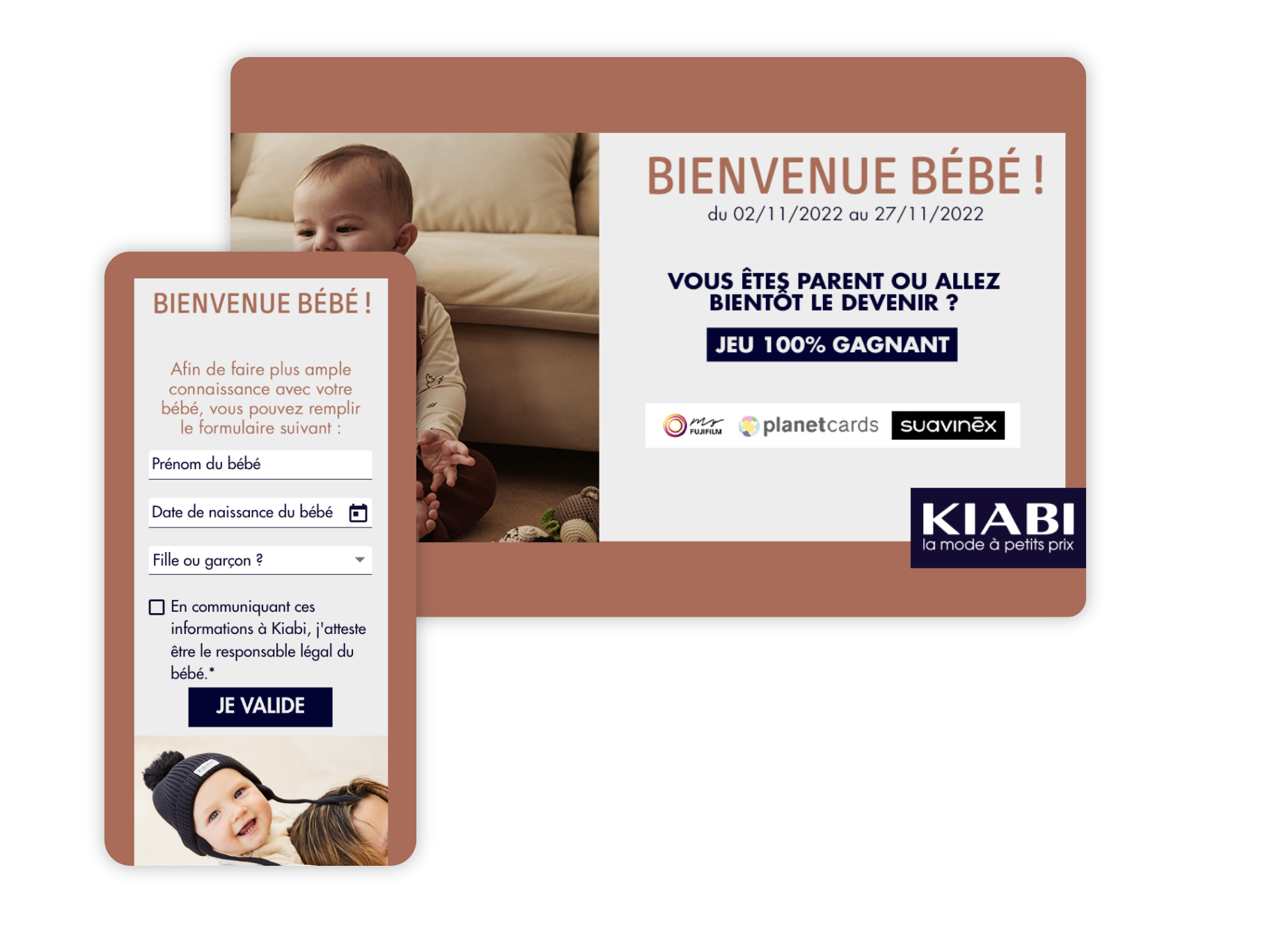
2. Engaging prospects and customers through interactive experiences
Gamification is an essential tool for capturing the attention of potential customers and encouraging them to interact with a brand. En intégrant des mécanismes inspirés des jeux dans leur campagne marketing ainsi que dans le parcours d’achat, les marques peuvent augmenter la récurrence mais aussi la durée des interactions avec leur audience.
Gamification makes interactions between the brand and its customers positive, and therefore memorable. Games naturally capture attention and motivate users to participate, thanks to rewards or challenges. Games also provide an immersive brand experience. Shoppers feel more involved and entertained, which creates a positive emotional relationship with the brand.
For its 70th anniversary, Boulanger launched an interactive quiz highlighting the brand’s world and history. The operation was a great success, attracting a large number of participants. With a 95% success rate in the Quiz, this initiative was able to mobilise a large audience, reflecting users’ interest in the brand and its offers, with over 18k clicks on the offers at the end of the game.
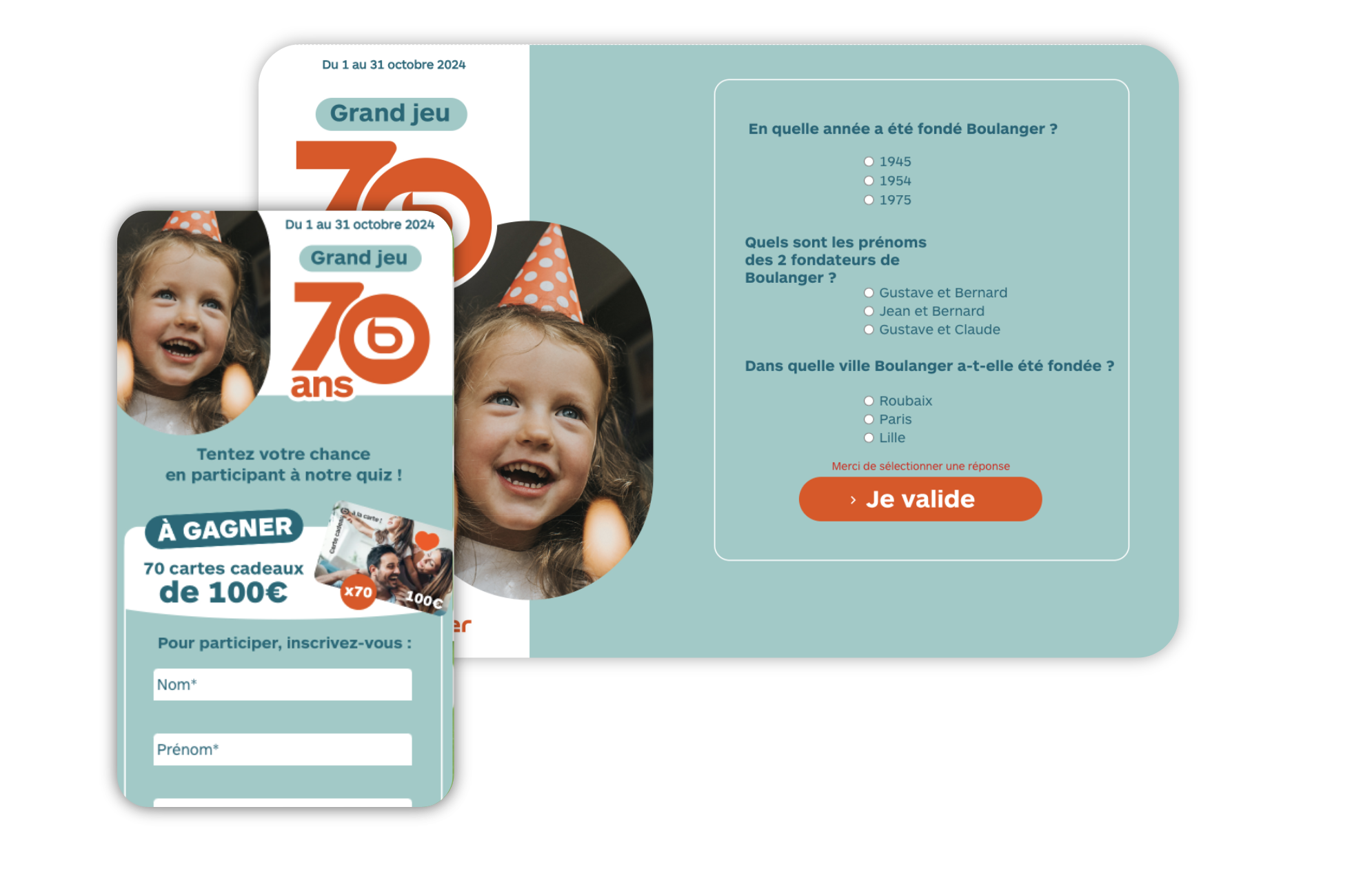
3. Boost your conversion strategy to generate more sales
Gamification is also a powerful lever to help brands generate more sales. First and foremost, it’s an excellent way of gaining visibility and attracting buyers’ attention with an entertaining experience (like a Winning Instant or an Advent Calendar, for example).
Playable marketing or the gamification of the customer journey fits perfectly into a Drive-to-Store strategy or Drive-to-Web. For example, visitors to a website can take part in an online game and win a voucher to spend in shop.
Conversely, in-store customers can access a game via a QR code, for example, after their purchase and be redirected to the brand’s online shop or app for more information. In both cases, players are encouraged to discover their gift or take advantage of a discount coupon, generating more traffic to the brand’s various contact points.
Finally, gamification can be used to better retarget qualified leads (with product suggestions generated on the basis of data collected during the game).
To boost your conversion strategy, Lindt has bet on playable marketing. The brand exceeded its lead generation target with 19k new opt-ins thanks to a virtual Easter egg hunt. The campaign engaged a targeted audience, with each participant spending an average of 1 min 40 on the game. A gate code (uploading proof of purchase before being able to play) linked to the purchase of Lindt bunnies offered a chance to win a family weekend, boosting sales during this crucial commercial period for the brand.
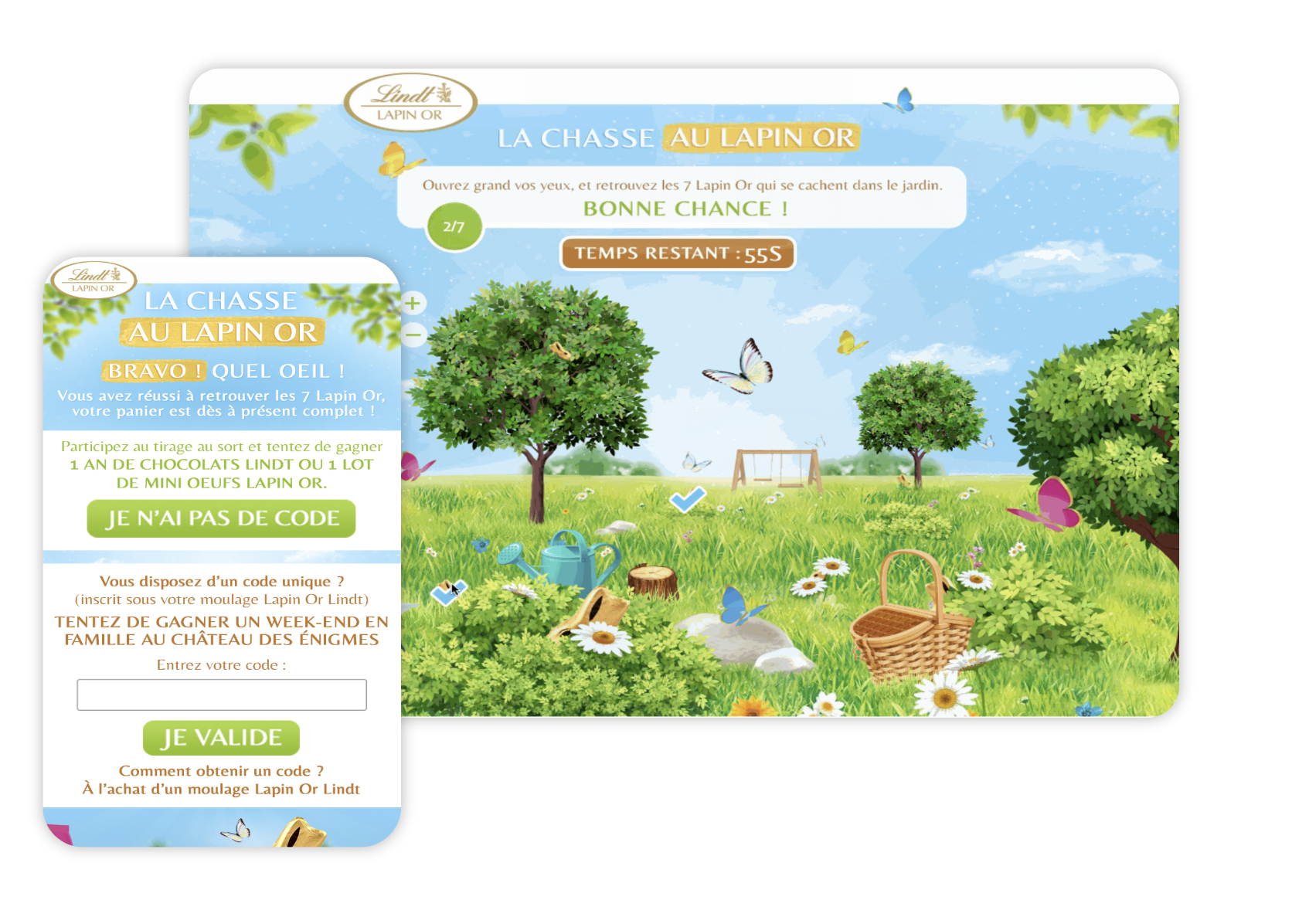
4. Building customer loyalty through original reward schemes
Building customer loyalty is a crucial dynamic for brands. It has a direct impact on their profitability and growth. Acquiring new customers costs between 5 and 25 times more expensive than retaining existing customers. A 5% increase in customer loyalty can generate an increase in profits of between 25% and 95%.
By increasing the number of interactions between the brand and consumers, gamification helps to consolidate the customer relationship. Elle offre aussi aux enseignes des original ways of rewarding buyers and encourage them to continue ordering from them. Gamified loyalty programmes stimulate customers to climb the ladder to pass levels and unlock new rewards.
But other game formats such as Surveys and Customizers can also boost customer retention by giving them a voice and promoting their creativity. In this way, the brand collects feedback on its products (via a survey), continuously improving the experience offered. It can also offer opportunities for collaboration/co-creation (via the Customizer, for example), proposing items that are more likely to appeal to its audience.
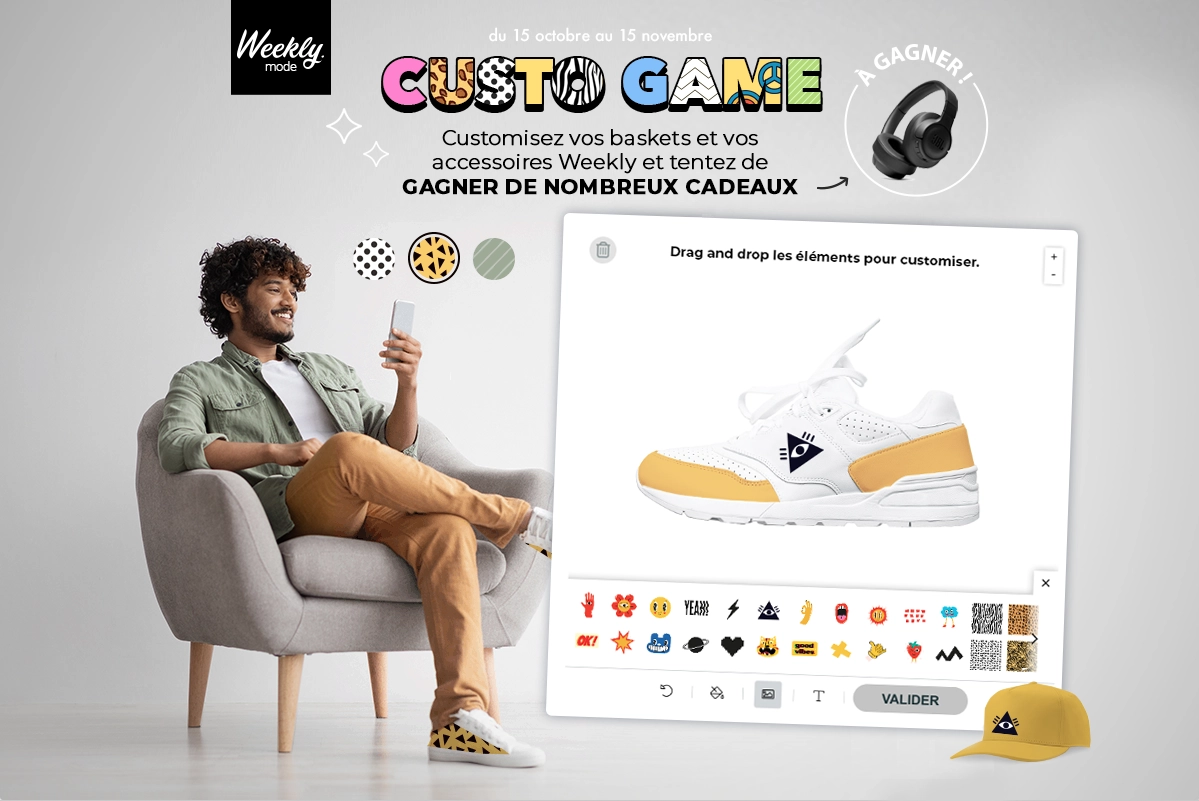
How do you gamify marketing?
Gamification therefore has the potential to transform the way companies communicate and engage their customers . To boost their marketing strategy, all they have to do is introduce playful mechanics into the strategic aspects of their brand experience. Here are the key steps for getting started with Playable Marketing.
1. Defining your objectives
First and foremost, it is crucial to clearly define your objectives. A brand that embarks on a gamification strategy will have much more impact if it targets a specific strategic outcome. The aim is to use this new lever to reduce the friction experienced by its customers or to reinforce the stage of its sales funnel that is performing least well.
In this way, brands can :
- Target engagement: increase the time spent on your application or website;
- Generate leads: capture customer information via a form that precedes or follows the game mechanic and collect optins (by integrating a push optin into the game path);
- Educating customers: making products and services more understandable through interactive and educational mechanisms;
- Improve loyalty: gamify your loyalty programme, etc.
2. Identify your target audience
The Playable marketing strategy must also be adapted to the audience the brand wants to reach. Si le marketing jouable offre à l’entreprise des outils de collecte de données, il est important, en amont, d’étudier sa cible pour comprendre :
- Online behaviour;
- Their preferences (particularly in terms of communication channels, types of interaction, etc.);
- Their expectations/bain point (to offer attractive prizes, which will naturally boost the participation rate).
3. Choosing the right game mechanics and rewards
Depending on its strategic objectives and target audience, the brand can then turn to the most appropriate gamification mechanism. For example, instant-win formats (which immediately tell players whether or not they have won) are particularly useful for raising brand awareness and generating sales through the distribution of promotional codes.
The choice of endowments is also crucial. Users must feel there is real value in taking part, whether through material or symbolic rewards, as well as exclusive benefits (behind-the-scenes access to the brand, never-before-seen content or premium services).
4. Get the right equipment and surround yourself with the right people
Gamification requires the use of a specialised platform such as Adictiz for example, which gives them access to a wide catalogue of playable formats. You then need to be able to choose the right mechanics, customise the gameplay and the graphic universe of the campaigns so that it is aligned with your objectives and consistent with the brand’s universe.
A platform like Adictiz is often more than just a platform. There are usually additional services to manage the campaigns (data segmentation solution, modules for sending automatic emails to participants, CRM connectors, custom developments, etc.). .
The design studio Adictiz provides brands with a step-by-step guide to creating their campaign. Not forgetting the Media Agency, which boosts performance through a tailor-made media strategy and real expertise in digital marketing (social ads, emailing, etc.)
5. Test and measure results
To guarantee the effectiveness of a gamified marketing strategy, it is important to adopt a continuous improvement approach. It is therefore important to :
- Launch an initial pilot campaign to test what works before extending it;
- Track strategic KPIs: participation rate, time spent, leads generated, conversion, etc.
- Adapt and optimise future playable marketing campaigns by adjusting the mechanics used, the player journey or the rewards offered according to the feedback.
Conclusion
Gamification is a powerful lever for transforming your future marketing campaigns into interactive, high-performance marketing campaigns. By maximising interaction with your audience and rewarding your users, you can increase their satisfaction and loyalty and, ultimately, your marketing performance. Adictiz can help you design high-impact campaigns that are tailored to your objectives and your target audience! Discover our interactive mechanisms and services tailored to your needs!


